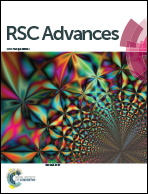A versatile method to prepare size- and shape-controlled copper nanocubes using an aqueous phase green synthesis†
Abstract
We demonstrate a versatile, simple, and environmentally friendly method for preparing copper nanocubes with controlled morphology in aqueous solution at room temperature. Copper(II)chloride is used as a precursor and the reduction is performed under an argon atmosphere with milder and non-toxic sodium borohydride in de-ionized water. The molar ratios of the precursor and the reducing agent, and sodium borohydride addition time play a key role in the preparation of copper nanocubes with an average edge length in the range of 100 ± 35 nm. With the addition of 20 w% poly(vinylpyrrolidone) prior to the addition of the reducing agent, well-dispersed PVP-capped copper nanocubes were also prepared in considerably good yield. The UV-visible absorption traces and transmission electron microscopy analysis were used to monitor the formation of copper nanocubes. The powder X-ray diffraction (XRD) and selected area electron diffraction (SAED) reveals the packing of copper nanocrystals to cubic 3D structures.


 Please wait while we load your content...
Please wait while we load your content...